NBRC Sleep Disorder Specialist Exam
1/159
Earn XP
Description and Tags
National Board of Respiratory Care - Sleep Disorder Specialist
Name | Mastery | Learn | Test | Matching | Spaced |
|---|
No study sessions yet.
160 Terms
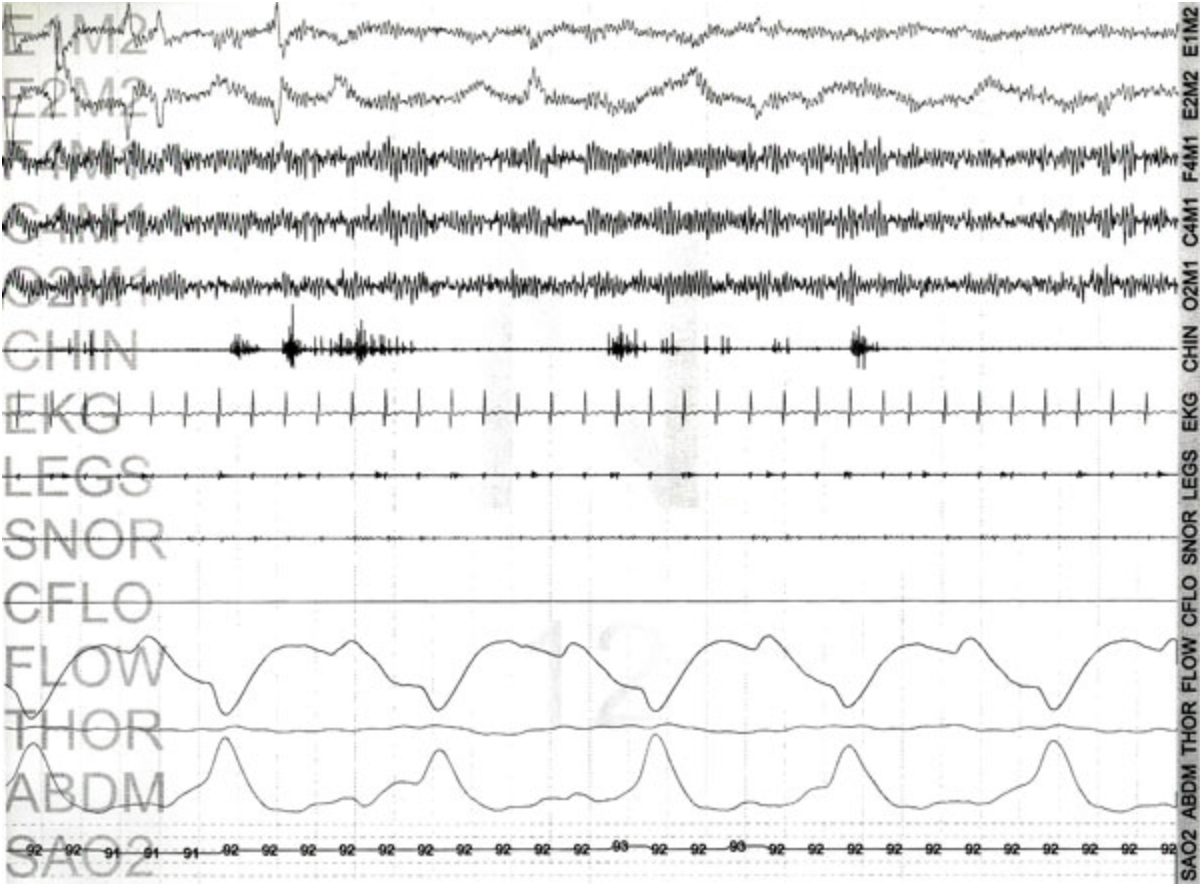
Which of the following channels should be adjusted?
THOR
Education about optimal CPAP should emphasize using the device
while sleeping and with naps
A patient with known sleep apnea has been referred to an in-hospital sleep center for implementation of a CPAP order written by a primary care physician. The patient is concerned he will not be able to wear the interface the required number of hours. The patient is very anxious, and there has been no order for medication to ease the transition. Which of the following is the best INITIAL action for a sleep disorders specialist to take with this patient?
Discuss desensitization therapy with the patient
An adult with history of insomnia and hypersomnolence presents to a sleep clinic for a PSG. At the conclusion of the study, the AHI is 2, and the lower extremity myogram shows repetitive activity followed by arousals during stages 1 & 2 & NREM. A sleep disorders specialist should consider which of the following diagnoses?
PLMD
The following data are obtained during the first 120 minutes of an in-laboratory PSG for an adult patient with COPD.
Total AHI: 4.8
Supine AHI: 5.3
Nonsupine AHI: 2.5
Mean SpO2: 87%
SpO2 nadir: 80%
Oxygen is initiated at 2 L/min. After 60 minutes, analysis of respiratory events and body position reveals:
Total AHI: 4.7
Supine AHI: 5.2
Nonsupine AHI: 2.5
Mean SpO2: 93%
SpO2 nadir: 90%
A sleep disorder specialist should NEXT
continue the PSG with the current therapy
An adult patient is undergoing a PSG in an in-hospital sleep center. Two hours into the study, a sleep disorder specialist notes the ECG suddenly goes flat. The specialist should FIRST
check the patient
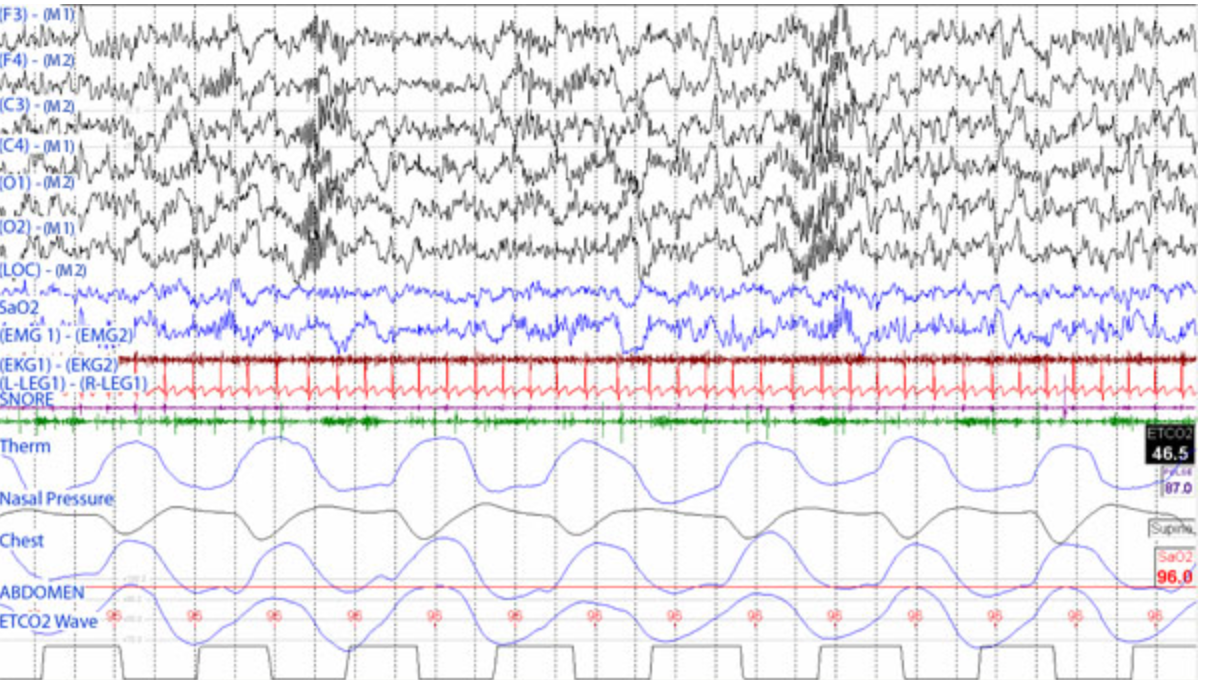
A sleep disorders specialist notes the following epoch while scoring an overnight study of an adult. This should be scored as stage:
N2
The morning after a sleep study, a patient asks a sleep disorders specialist when the results will be available. Which of the following is an appropriate response?
“A physician must review the results first”
An 8 year old patient in stage R has a respiratory rate of 24/min and a 9-second period without airflow and respiratory effort. How much does SpO2 have to drop for this event to be scored as a central apnea?
3%
During a daytime study, smoke is seen coming from the kitchen in a freestanding sleep center. On closer observation, there are smoke and flames coming from the oven, and the kitchen is filled with smoke. A sleep disorder specialist concludes that the occupants are in danger. What should the specialist do NEXT?
Remove patients from the area
Which of the following are required for a CPAP prescription?
Pressure setting
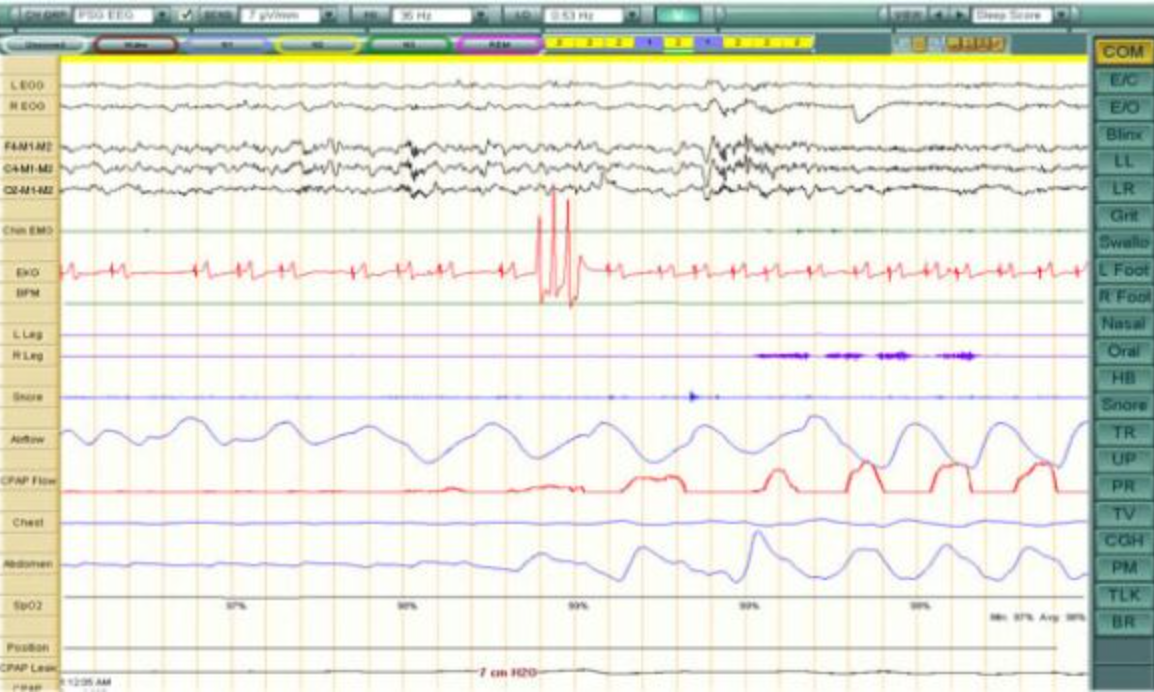
An adult patient has been diagnosed with OSA. During a CPAP titration, the following 30-second epoch is obtained at 10/mm sec. The EEG abnormality at the end of the respiratory event can be described as
Ventricular tachycardia
A 17-year old patient with a tracheostomy tube in place presents to a sleep center for a diagnostic PSG. During the procedure, the tracheostomy tube is capped. The results show an AHI of 0.5 with a mean SpO2 of 92% while breathing air. The patients PeTCO2 was greater than 45 mm Hg for 50% of the TST, and greater than 50 mm Hg for 30% of the TST. These values indicate
Sleep-related hypoventilation
According to the AASM manual, the elapsed minutes between lights out and lights on are considered
Total recording time
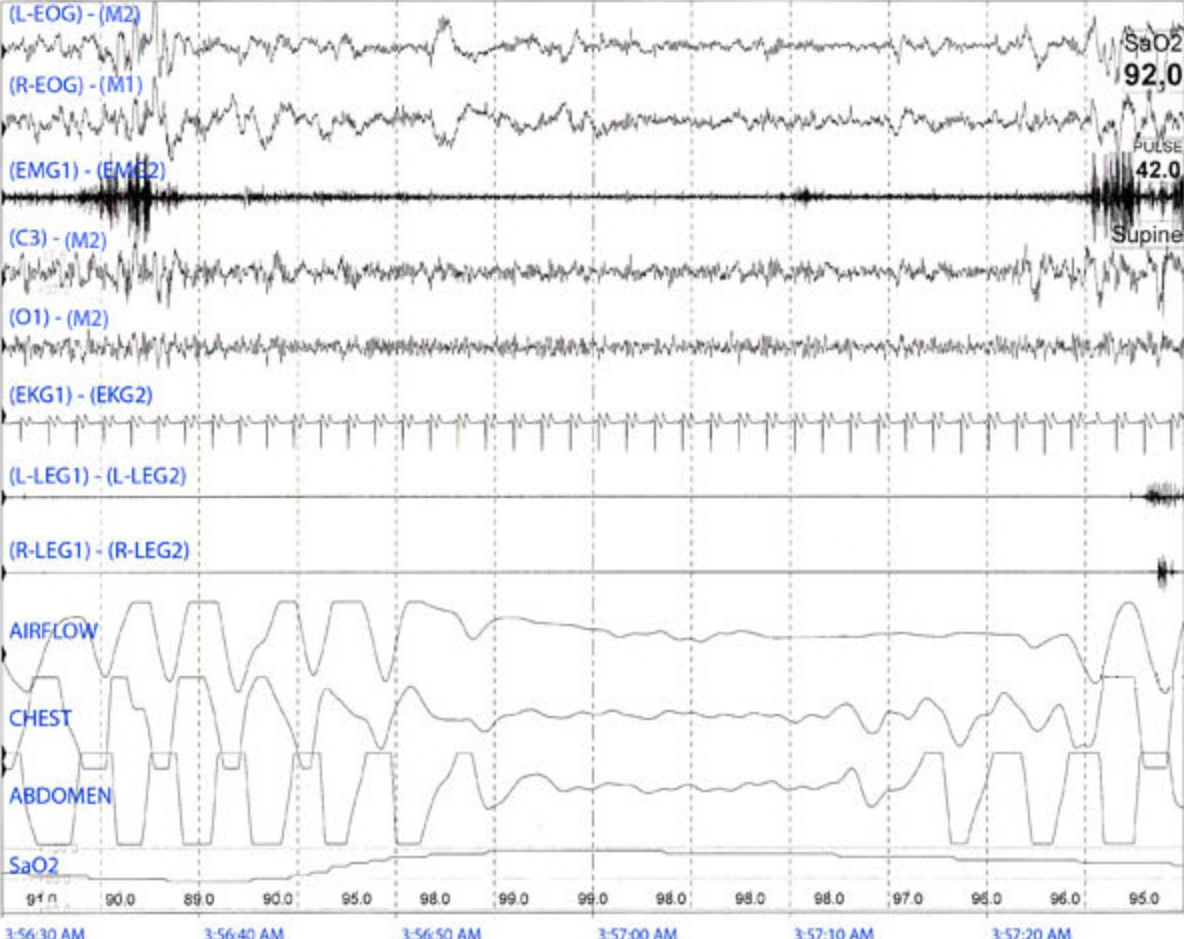
The following 60-second tracing is observed while scoring study results for an adult patient. Which of the following types of apneas best describes the event in this tracing?
Mixed
A sleep disorders specialist notes the following cardiac rhythm during the first REM period of an overnight PSG. Which of the following should the specialist do next?
Evaluate the patient
A sleep disorder specialist is titrating CPAP for an adult patient using a nasal mask. The specialist increased the CPAP gradually in 2 cm H2O increments. Apnea and hypopnea events stopped with a CPAP of 10 cm H2O. The patient continues to have mild snoring episodes. Which of the following should the specialist do next?
Increase pressure by 1 cm H2O
Appropriate placement of a snore sensor should be verified by
Asking the patient to perform a sustained humming noise
A patient with OSA is titrated on CPAP to resolve obstructive respiratory events. Supplemental oxygen is added to correct persistent hypoxemia. The following readings are observed:
Air: 84%
1 L/min O2: 87%
2 L/min O2: 90%
3 L/min O2: 93%
4 L/min O2: 96%
What is the minimally acceptable oxygen flow setting to use for this patient?
2
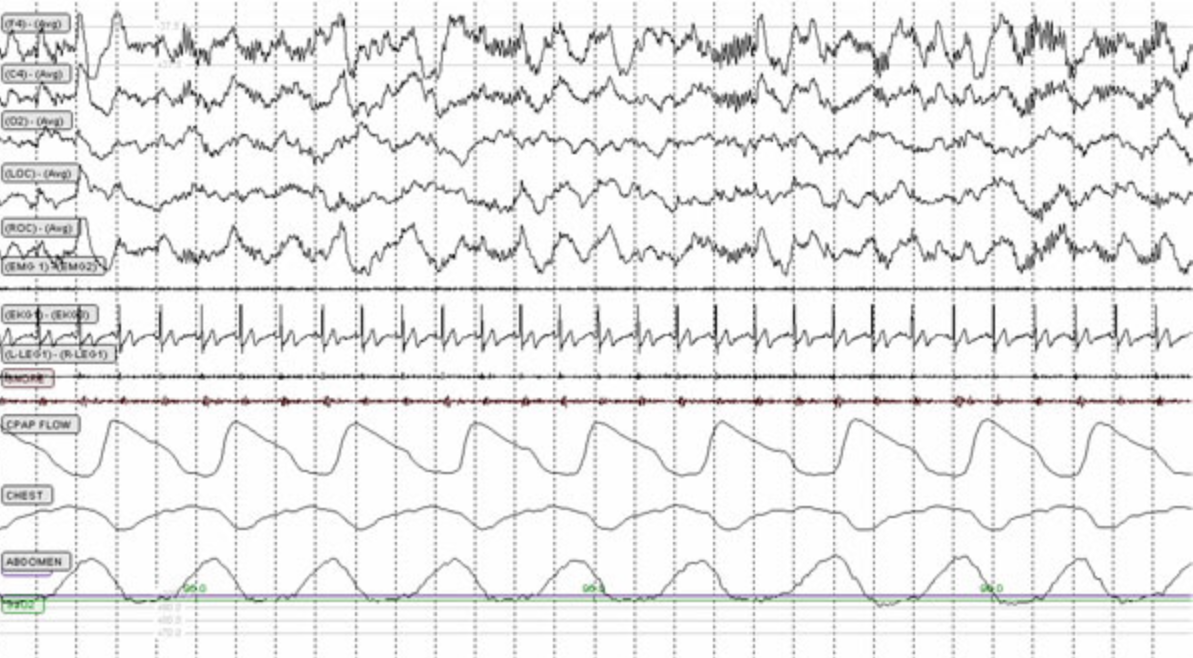
The following 30 second epoch is observed while scoring on an adult patient. This epoch should be scored as stage
N3
A 45 year old patient with a deviated septum has been diagnosed with severe OSA. While a sleep disorders specialist is choosing the mask for home use, the patient complains that the large nasal mask used during CPAP titration seemed to leak into her eyes and caused nasal congestion. A leak of 1.0 L/sec was noted during titration. Which of the following should the specialist select for this patient?
A full face mask
A sleep disorders specialist reviews the following sleep diary for a 30 year old patient who reports difficulty falling asleep. The patient complains of daytime fatigue. Which of the following tests should a sleep disorder specialist recommend FIRST for evaluation?
Actigraphy
A patient comes to the sleep clinic with a CPAP machine and says the pressure does not feel as strong as before. Data download shows:
% of nights > 4 hr: 96%
Time in large leak: 6 sec
Residual AHI: 2.4
Which of the following should a sleep disorders specialist do FIRST?
Check the filters
One month after starting CPAP by nasal mask to treat OSA, a patient complains of high pressures and masks leaks. A sleep disorders specialist reviews the following download data:
88% use greater than 4 hours on auto-CPAP 13-20 H2O
AHI is 1.8 with 90th percentile of 13 cm H2O and 2% large leak
Repeated use of the ramp feature
Which of the following should the specialist recommend FIRST?
Reduce auto-CPAP to a minimum of 9 cm H2O
A 3’3 (99 cm), 36 lbs (16 kg) 4 year old child is referred for evaluation because of loud snoring. The patient has a benign nasal examination and has enlarged tonsils on oropharyngeal examination. Chest and heart examinations are within normal limits. An in-laboratory PSG is performed, revealing the following data:
TST: 510 mins
N1: 6%
N2: 40%
N3: 30%
R: 24%
AHI: 3.2
Nadir SpO2: 92%
Which of the following should a sleep disorder specialist recommend?
Refer to ENT for tonsillectomy
Which of the following is the most common barrier to use of PAP therapy?
Interface intolerance
A patient with severe OSA is referred for CPAP set-up. Several mask interfaces have been tried without success. The patient is concerned because a brother with OSA died of a heart attack while using CPAP. To best encourage effective desensitization, a sleep disorders specialist should FIRST address the patient’s
Anxiety
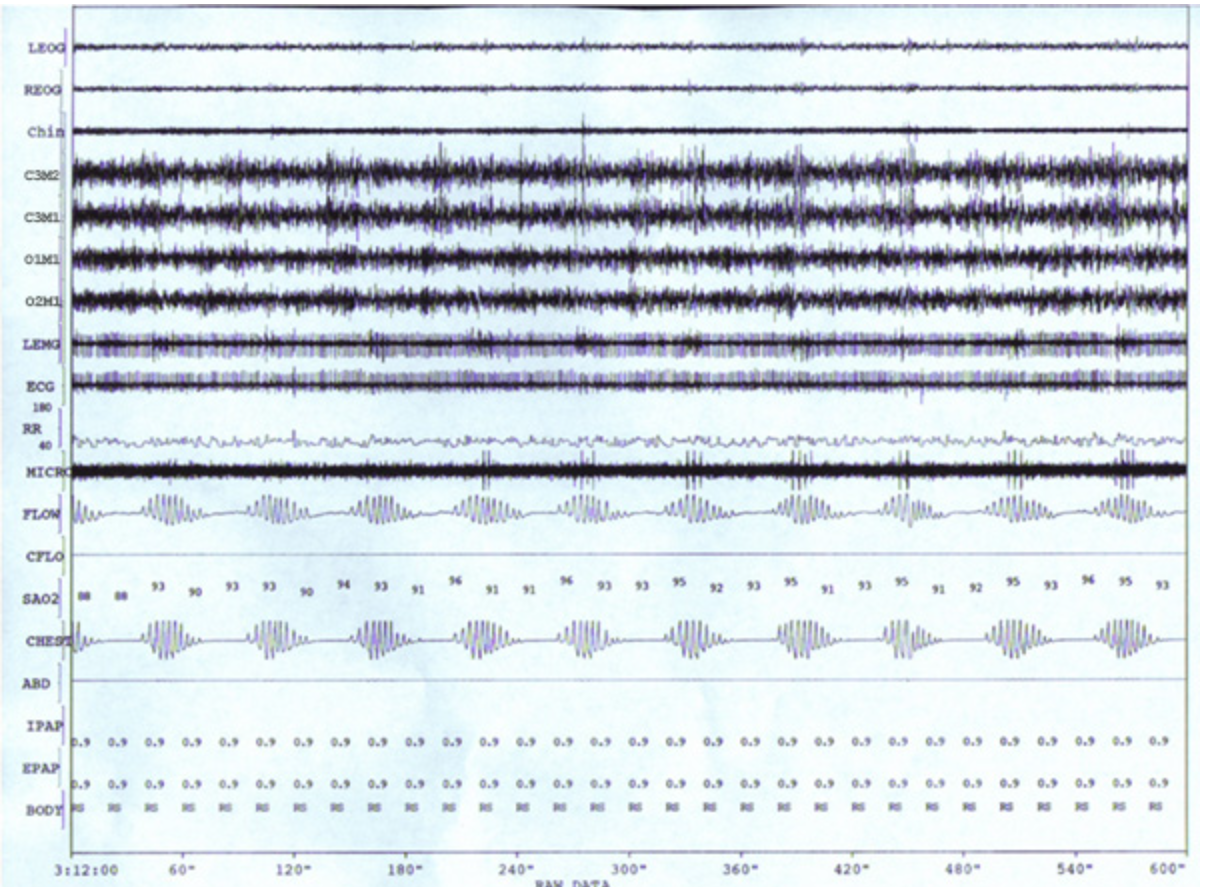
A sleep disorder specialist evaluates the following 10-minute compressed view of a PSG performed on an adult patient. Which of the following should the specialist conclude about the respiratory pattern?
It is associated with an increased risk of mortality
When reviewing an adult patient’s chart before an in-lab PSG, a sleep disorders specialist notes the patient complains of excessive daytime sleepiness, witnessed apneas, snoring, frequent sleep talking, and occasional swinging of arms during sleep. The specialist should recommend the physician add which of the following to the order?
Extra EMG leads
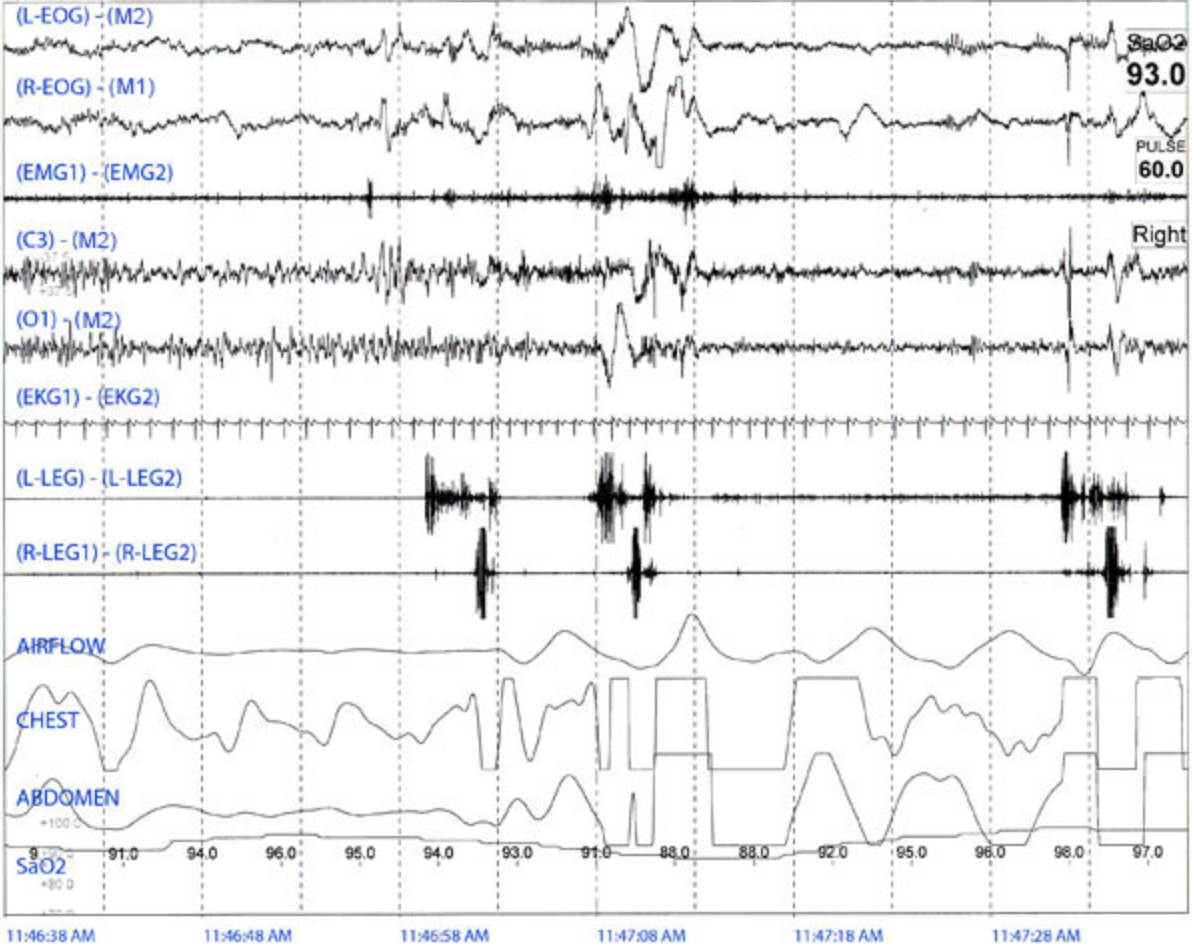
A sleep disorder specialist observes the following 60 second epoch while analyzing the results of a sleep study of an adult. The specialist notes the pattern repeats for the next 30 minutes. Which of the following is the most likely cause for these findings?
Obstructive apnea
A sleep center is located across from the street from an ED. A hospital helicopter had landed twice, which has caused the patient to awaken and remain awake. A sleep disorders specialist should
Document the reason the patient did not sleep
A patient presents for a 6 week follow up after using 10 cm H2O nasal CPAP. The patient reports feeling better, but is still experiencing some daytime tiredness, occasional snoring, and a very dry mouth in spite of using a chin strap and heated humidity. The downloaded CPAP data shows a significant leak. A sleep disorders specialist should recommend
Fitting the patient for a full face mask
A 25 year old patient undergoing an in-lab PSG awakens during the study and complains of pain in the middle of his chest characterized as a burning sensation that lessens when he swallows. This is most likely
Gastroesophageal reflux
Respiratory effort can be assessed by evaluating
EMG
During a PAP titration, increased nasal airway resistance is most likely to occur when air is
Dry
Hypertension and excessive daytime sleepiness are conditions most strongly associated with
OSA
According to CMS guidelines, a scored hypopnea requires which of the following percentage decreases from baseline SpO2?
4

CPAP titration was performed for a 41 year old patient diagnosed with severe OSA & the following data was recorded.
At the 1 month follow up, data download shows the patient stopped using the CPAP device after two weeks. He says he stopped because 12 cm H2O is “too much pressure”, although he says the ramp feature offered some relief. A trial of desensitization with various masks is not effective. Which of the following changes to the treatment plan should a sleep disorders specialist recommend NEXT?
Switching to auto-PAP therapy
An adult patient received CPAP equipment and has been trained on its use and maintenance. The patient uses a humidifier for comfort. Later the same week, the patient calls the sleep clinic to complain there is water in the tubing. A sleep disorders specialist should instruct the patient to
Decrease the humidifier temperature setting
When other treatments fail, the definitive treatment for OSA is
Tracheostomy
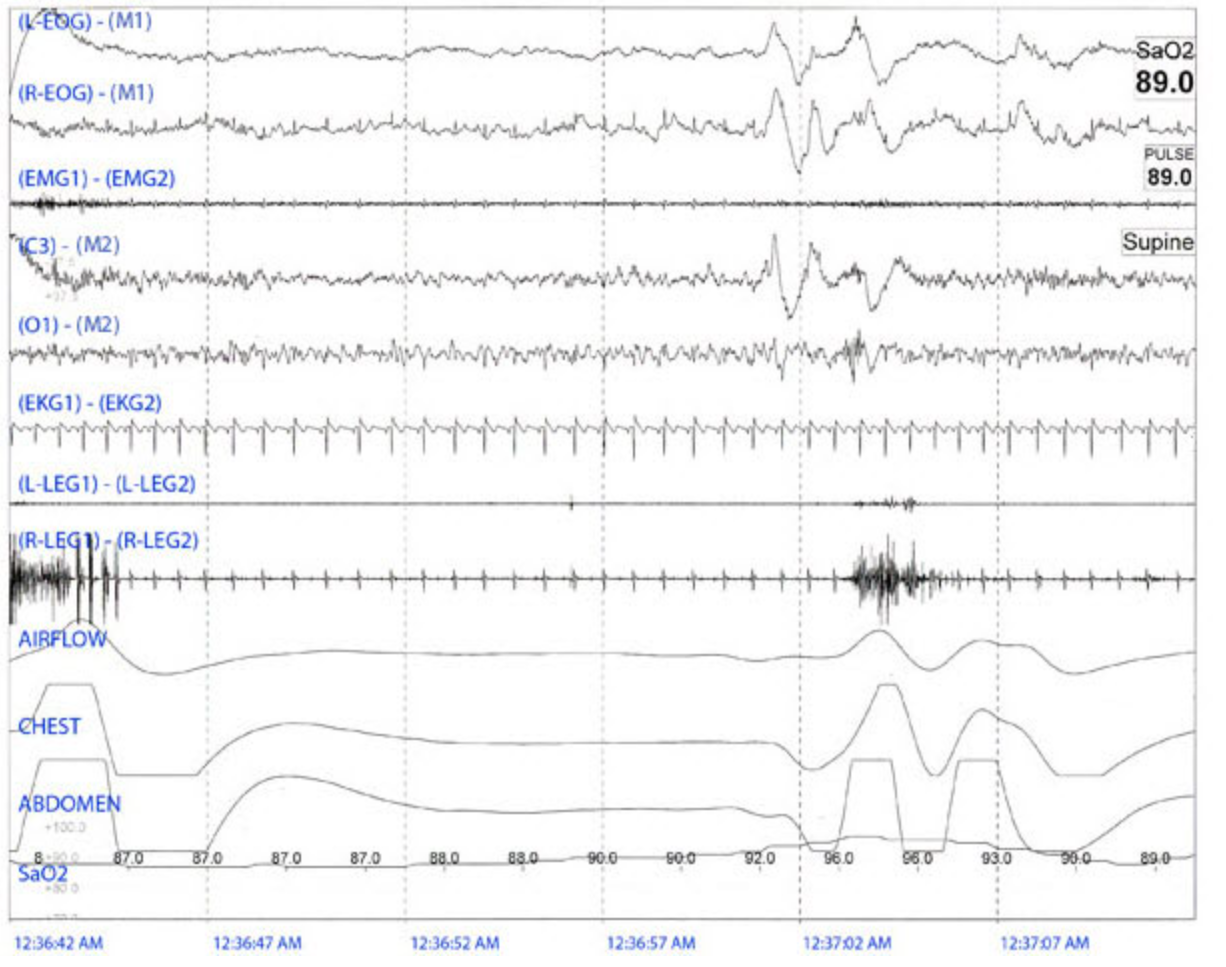
The following 30 second epoch is observed during a sleep study of an adult. Which of the following is shown? S
Central apnea
During an in-lab PSG, an adult patient experiences an event consistent with his history of abnormal sleep related behavior usually occurring between 3 and 6 am. During study analysis, which of the following is critical to assess?
Sleep stage during the event
High voltage bursts of paroxysmal theta activity are observed with a diffuse distribution in the EEG of an 11 year old. The video shows that the room lights were on, the patient’s eyes were closed, and no body movements were seen. For scoring, which of the following best defines the EEG activity?
Hypnagogic hypersynchrony in stage N1 sleep
A sleep disorders specialist reviews HSAT results for a 45 year old patient with a BMI of 36 kh/m² and an ESS score of 16. Results show a total REI of 3.8 and a supine REI of 16. The specialist should FIRST recommend
Positional therapy
During PSG testing, a sleep disorders specialist observes the patient frequently swallowing and there are arousals associated with dry coughing. Which of the following should the specialist suspect?
Gastroesophageal reflux
Which of the following should be recommended FIRST for a patient with severe sleep apnea who has a deviated septum?
Full face mask
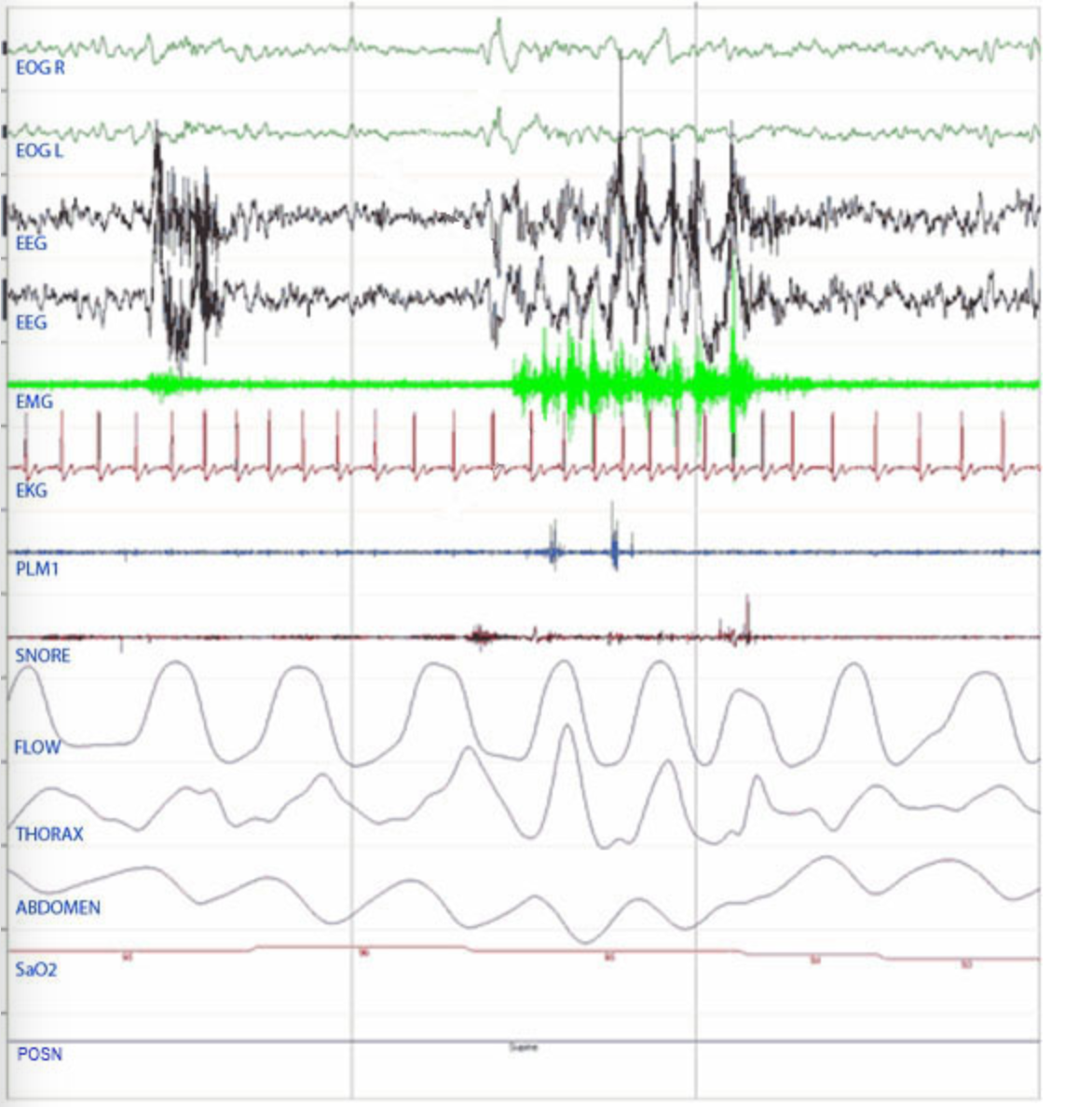
The following 30 second epoch is observed. Which of the following is most consistent with these findings?
Bruxism
During an in-lab PSG, respiratory effort is present throughout an event, but there is no airflow. This is most consistent with
Obstructive apnea
A school bus driver is on medical leave because he dozed off and drifted out of his lane. He is subsequently diagnosed with OSA. A titration study is performed, and CPAP therapy initiated. Two months later, review of the download data shows acceptable adherence, sleep duration, and efficacy. Which of the following results is best to evaluate the patient’s ability to safely return to work?
MWT
During a split night PSG, an adult patient without known comorbidities has been asleep for 120 minutes. According to CMS criteria, what is the minimum number of respiratory events to occur in this time period for the patient to subsequently qualify for CPAP therapy reimbursement?
30
A sleep disorders specialist recieves a call at the sleep center from a patient who had a sleep study done more than a year ago. The patient says he is compliant with CPAP therapy, but has developed a pressure sore on the bridge of his nose. The specialist should
Schedule a clinic visit to evaluate the mask
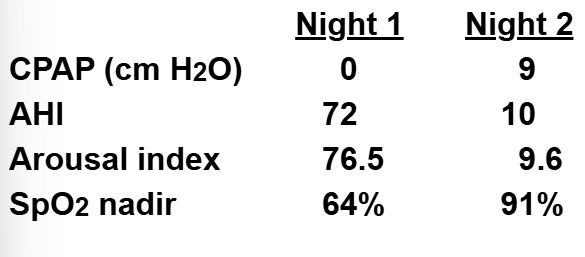
A sleep disorders specialist is preparing to set up CPAP for a 35 year old patient with Trisomy 21 and an ESS score of 14. The following PSG findings are noted.
A prescription is written for 7 cm H2O CPAP with nocturnal heated humidification and a large nasal mask. Which of the following should the specialist do NEXT?
Contact the ordering physician
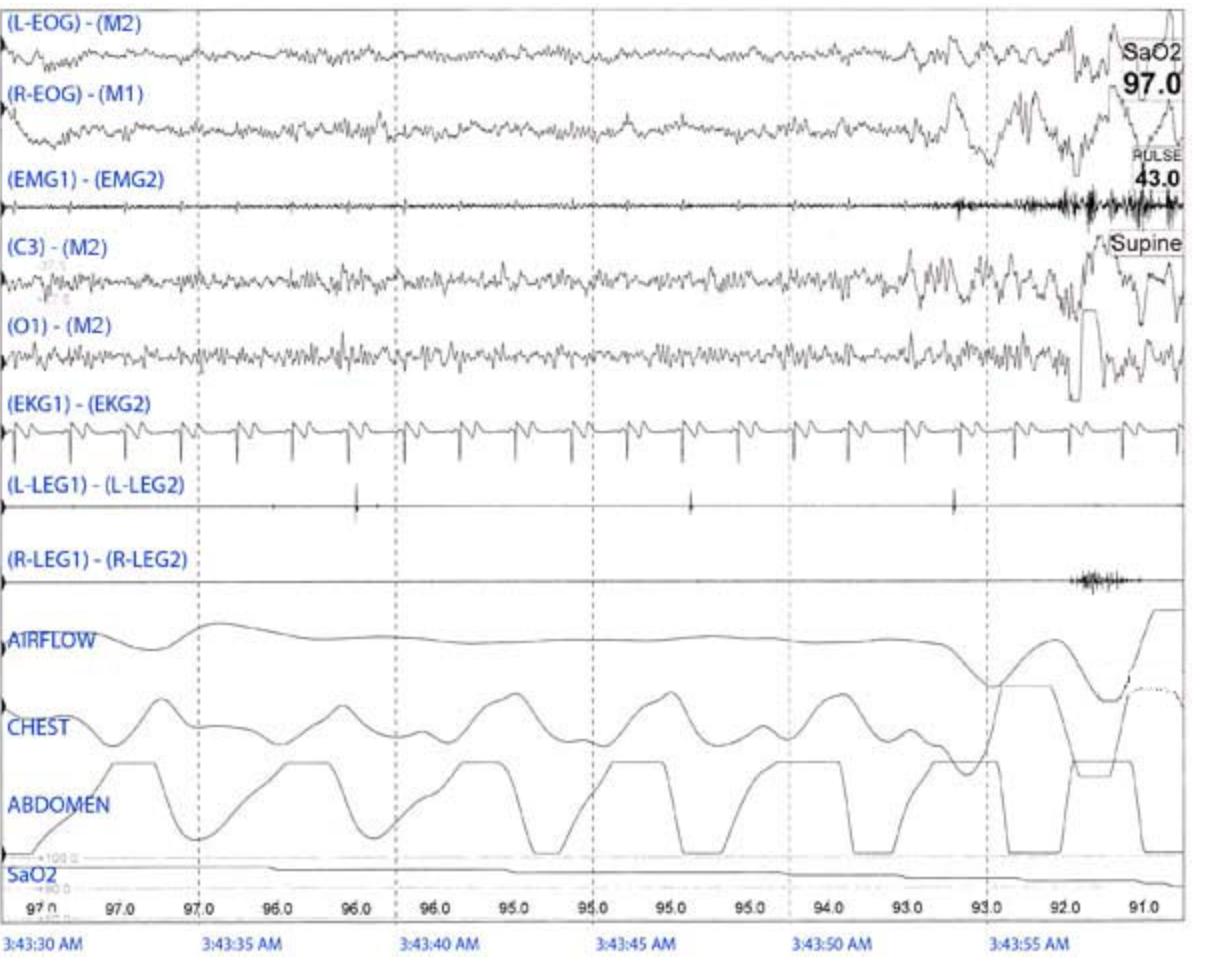
The following 30 second epoch is observed during a sleep study of an adult. The patient will most likely require therapeutic intervention for
Obstructive apnea
An in-lab PSG is planned for a 3 year old child. To assist with ventilation measurement, a sleep disorders specialist should use
A PeTCO2 monitor
While scoring the sleep study of an adult patient with a history of somnambulism, a sleep disorders specialist should pay close attention to any movements in Stage
N3
Which of the following circadian rhythm sleep disorders is most likely to affect an otherwise healthy 72 year old patient?
Advanced sleep phase syndrome
Which of the following tests is most appropriate for a healthy patient with witnessed apneas and excessive daytime sleepiness?
HSAT
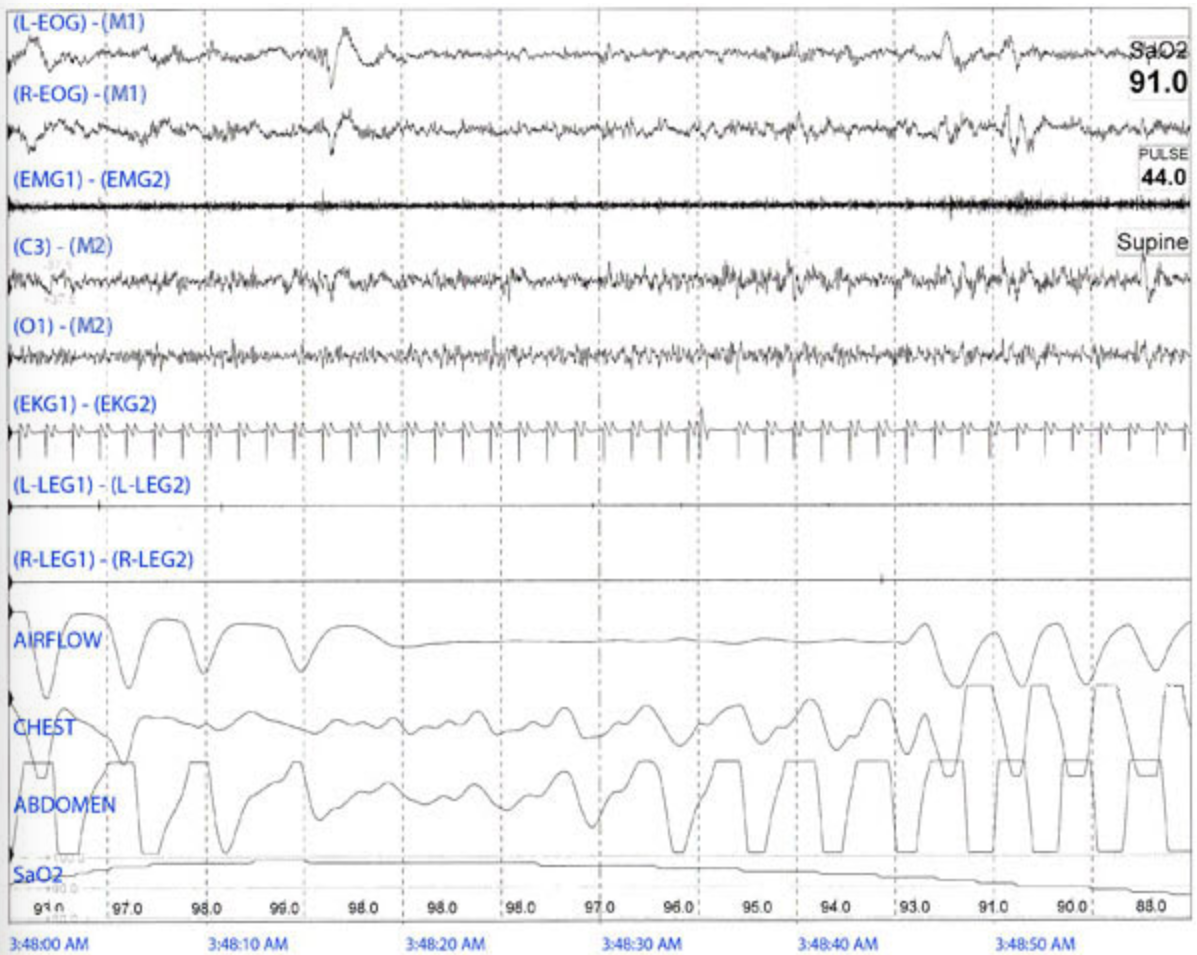
The following 60 second tracing is observed for an adult during testing. Which of the following events in this tracing is of greatest concern?
Desaturation
A patient presents to a sleep labatory complaining of daytime hypersomnolence with documented hypertension. After 183 minutes of sleep during a split night study, the recording reveals 20 apneas and 45 hypopneas. Baseline oxygen saturation is 92% with a low recorded saturation of 75%. A sleep disorders specialist should FIRST initiate
CPAP therapy with air
A 42 year old with a recently capped tracheostomy tube returns to a sleep center for evaluation following completion of an HSAT. While assessing the results, a sleep disorders specialist observes an apnea episode of 22 seconds concurrent with an undetctable SpO2 value. Consistently normal values for SpO2, breathing pattern, and heart rate prior to the event and immediately thereafter are observed as well. The patient does not recall any issues with the equipment. The specialist should recommend
Reporting the current results
During an HSAT, a 58 year old patient changes body position from supine to the left side. After the position change, the SpO2 values drop 10% from previous baseline with occasional signal drop. Roughly 45 minutes later, the patient returns to supine position, and the SpO2 value return to the previous baseline. A sleep disorders specialist should
Include all SpO2 information in the report with a note about patient position changes
While scoring an in-lab PSG for an adult patient, a sleep disorders specialist notes frequent leg movements occurring about every 60 seconds that are associated with respiratory events. How should the specialist document these leg movements?
Exclude them from the PLM index
A male patient weights 176 lbs (80 kg) and is 74 in tall (190 cm). This patient should be classified as
At a healthy weight
While performing a routine in-lab PSG, a sleep disorders specialist notes the ECG changes from a normal sinus rhythm with a rate of 72/min to supraventricular tachycardia with a rate of 180/min. As the specialist enters the room, the patient complains of chest pain and shortness of breath. There is no crash cart or AED immediately available. In addition to initiating oxygen, the specialist should
Activate emergency medical services
A sleep disorders specialist notes an irregularly irregular cardiac rhythm of 80/min in an adult patient during testing. This is most consistent with
Atrial fibrillation
During a sleep study, an artifact source is identified and corrected. Which of the following should a sleep disorders specialist do NEXT?
Document the action
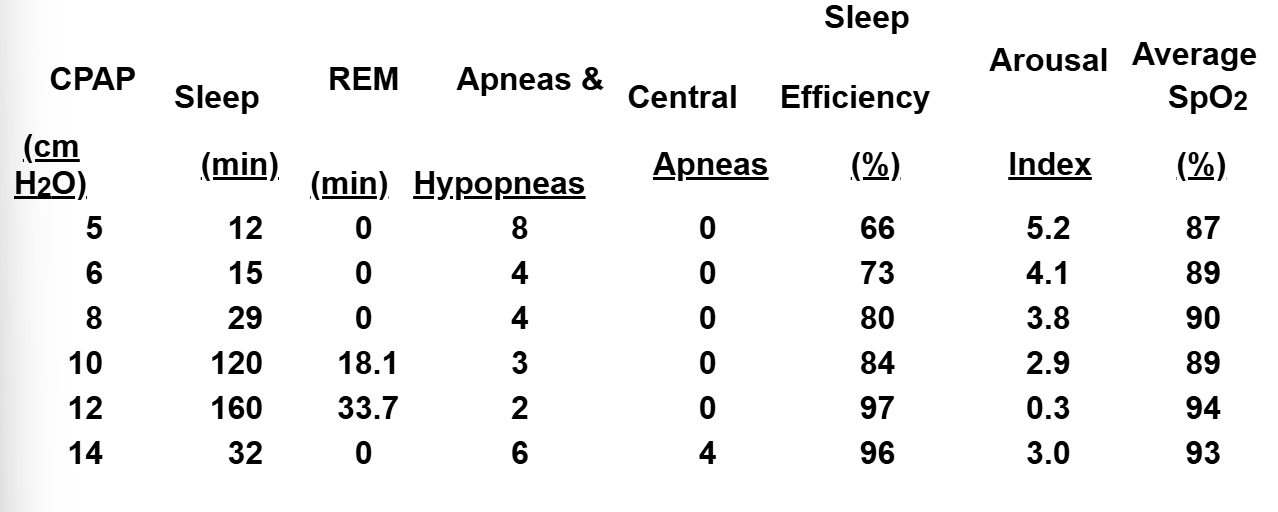
The following data are observed from a CPAP titration of an adult patient. What CPAP pressure appears to be optimally therapeutic? S
12
During a CPAP titration, apneas and hypopneas are eliminated at a pressure of 12 cm H2O, and SpO2 stabilizes at 96%. The patient continues to experience arousals following intermittent soft snoring. Which of the following should a sleep disorders specialist do NEXT?
Increase to 13 cm H2O CPAP
A sleep disorders specialist is reviewing HSAT download data for a 51 year old patient. The initial REI from autoscoring is 38 events per hour while the ODI is 10 events per hour. Which of the following should the specialist do NEXT?
Perform analysis of the raw data
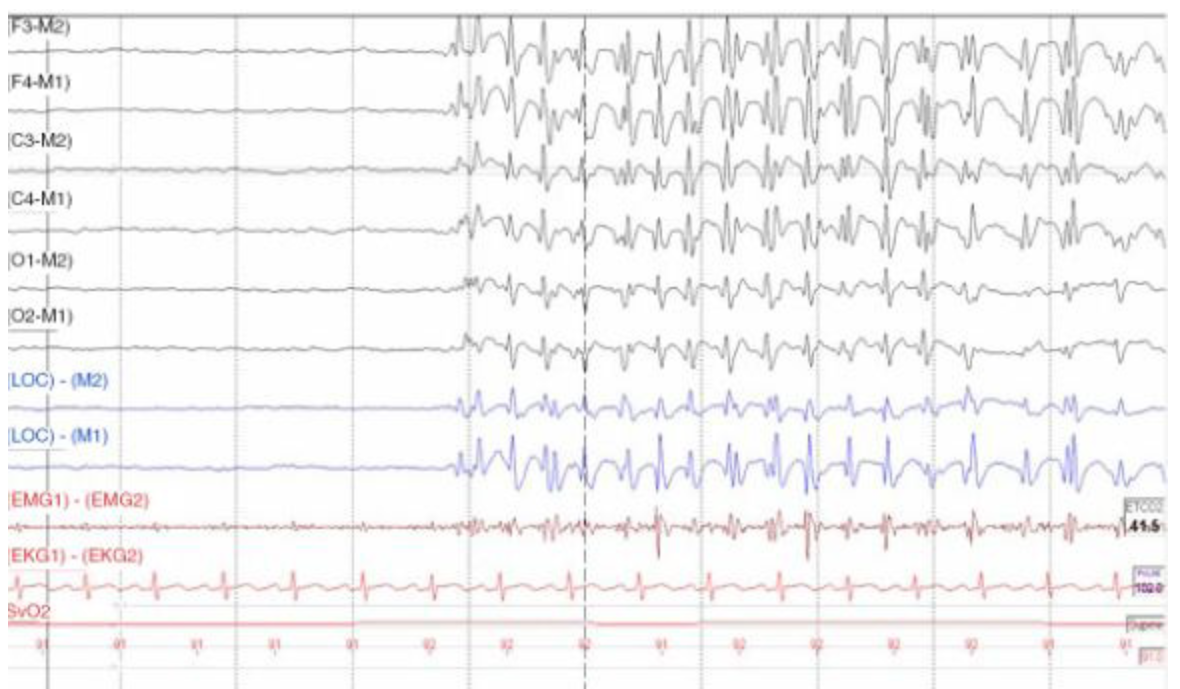
A 30 year old patient with a history of excessive daytime sleepiness, loud snoring, and witness apneas comes to a sleep center for a PSG. During conversation, the patient reveals a recent hospitalization for a head injury resulting from a motor vehicle crash. The following epoch is observed. Which of the following should a sleep disorders specialist document in the scoring record?
Possible seizure activity
In the absence of comorbidities, what is the minimum AHI required by CMS to initiate CPAP during a split night study, and have the patient’s subsequent CPAP therapy reimbursed?
15
The parents of a 5 year old report that the child snores and they have witnessed apneas for frequent, short periods throughout the night. An in-lab PSG is scheduled. During the confirmation call, a sleep disorders specialist discovers that the child sleeps with both parents. To prepare for the PSG, the specialist should arrange the room to accommodate
A parent in a separate bed near the child
A patient returns for a follow-up appointment complaining of difficulty tolerating PAP therapy. A sleep disorders specialist learns the patient also has frequent eye irritations. The specialist should communicate to the physician that the most likely explanation for the complaint is
An improper mask fit
During a sleep study for a patient who is morbidly obese, a sleep disorders specialist observes sustained reduced airflow and respiratory effort. This is most consistent with
Hypoventilation
Increased numbers of spindles and pseudospindles are commonly associated with the use of
Benzodiazepines
A sleep specialist is reviewing 2 consecutive nights of HSAT data for a patient. A valid SpO2 signal was obtained for 30% of the first night and for 0% of the second night. The specialist should
Send the equipment to the biomedical department

A 38 year old female is diagnosed with OSA during a diagnostic PSG. Auto-titrating CPAP is started, and she returns after a week for follow-up. She reports feeling less sleepy and says she is not waking up as many times at night as she was before starting treatment. A sleep disorders specialist reviews the following data. The specialist should recommend
Adjusting the minimum pressure to 8 cm H2O
After explaining each aspect of CPAP treatment to a patient, which of the following should a sleep disorders specialist do to confirm the patient’s understanding of the therapy?
Use the teach-back method
An adult patient presents to a sleep center with a primary complaint of difficulty maintaining sleep. The patient takes no medications. The patient’s bed partner reports observing quiet sleep without snoring or apneas. Two weeks of actigraphy the patient typically falls asleep between 7:30-8:30 pm and resumes activity between 3:30-5:00 am. These findings are most consistent with
Advanced sleep phase syndrome
Sleep onset occurred in epoch 25 and the first R stage occurred on epoch 225. The R latency should be reported as
100 minutes
If used on a daily basis, which of the following is most likely to affect a patient’s overnight PSG results?
Alcohol
A second transcutaneous monitor of the same make and model already in use in a sleep center has been checked by the biomedical department and put into service. To meet AASM accreditation requirements, which of the following should be done NEXT?
Add the new device to the monthly equipment inspection log
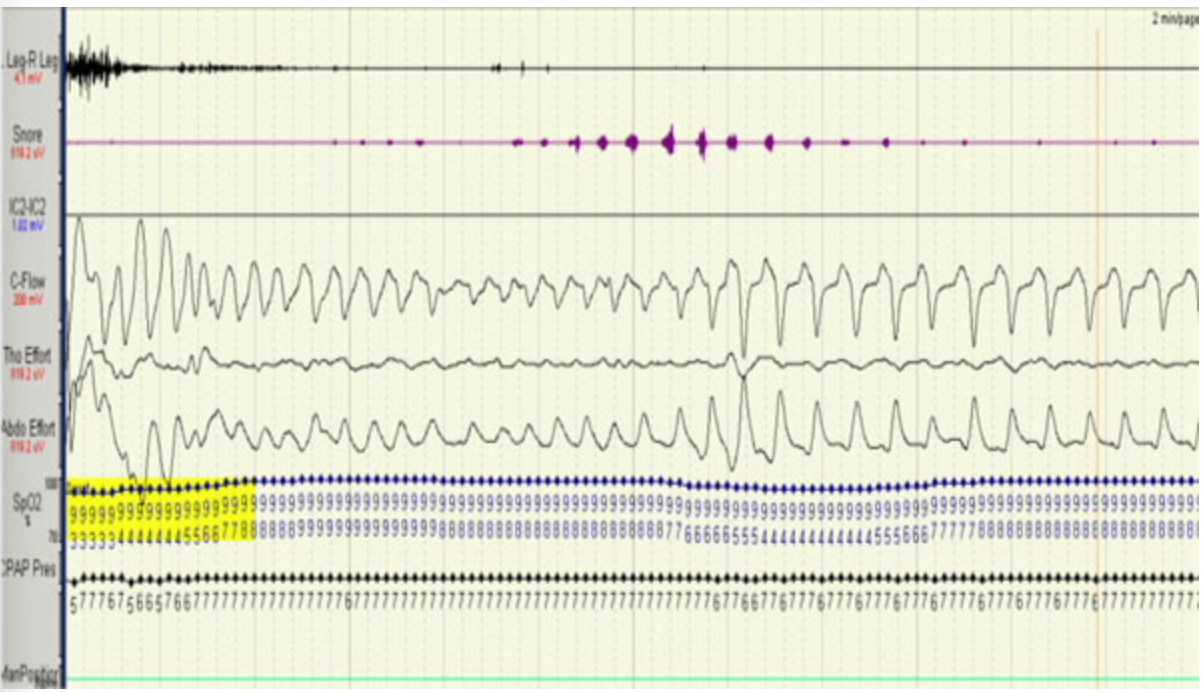
The following 120-second respiratory tracing is observed while an adult patient is in N3 sleep. Which of the following best describes the event in this tracing?
Hypopnea
While scoring a sleep study, the following patient spends # of epochs in different sleep stages.
Wake: 10 epochs
N1: 12 epochs
N2: 316 epochs
N3: 172 epochs
R: 144 epochs
How many minutes was the patient in NREM sleep?
250
At the conclusion of a split night study, a sleep disorders specialist should document the
Optimal PAP pressure
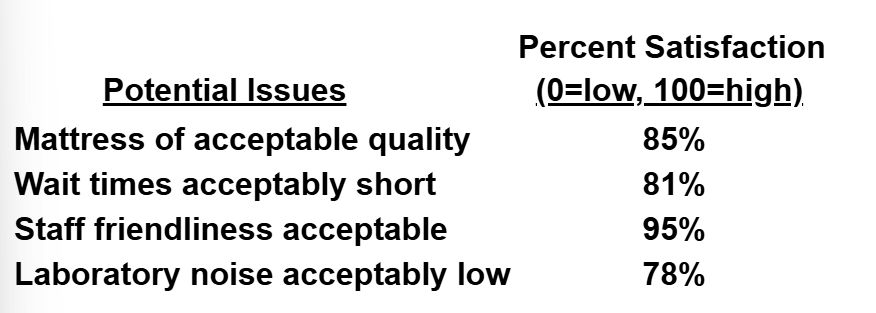
The following patient satisfaction data were collected from the last 100 patients immediately after their in-lab PSG. Which of the following should be the highest priority for quality improvement?
Noise levels

A 53 year old male who has used CPAP for 4 years with good results returns for follow up. He reports that the CPAP does not seem to be as “strong” as it used to be. Clinical evaluation reveals that he started taking diltiazem (Cardizem) 6 months ago and has gained 24.2 lbs (11 kg) since his last PSG. Review of the download for the past 180 shows the following. A sleep disorders specialist should FIRST recommend that the
CPAP pressure should be increased
Which of the following is associated with opioid use?
Decreased N3
Which of the following information listed on a post-study patient questionnaire is most useful following a CPAP trial?
Tolerance of therapy
A 39 year old with a history of spinal fusion secondary to lumbar disc herniation is referred for evaluation of excessive daytime sleepiness. The referral indicates pain management with opiates and antidepressants, that will be continued during the sleep study. Which of the following should a sleep disorders specialist expect to see in the PSG results?
Increased central apneas in non-REM sleep
Increased WASO results in
Reduced sleep efficiency
A sleep disorder specialist has completed a hook up for a PAP titration and runs the impedance check per AASM guidelines for pre/poststudy calibrations. The specialist notices that the C4, M1, and O2 electrodes have impedance values that range between 5.3-5.8 kilohms. Which of the following should the specialist do?
Reapply affected electrodes
The following PSG information are recorded for an adult patient.
Apneas: 40
Hypopneas: 22
Snores: 45
RERAs: 33
Total sleep time: 330 minutes
Total recording time: 390 minutes
What is the RERA index?
6
Comprehension of the treatment plan by a patient with a diagnosis of early dementia is best verified by
Asking the patient to explain the treatment plan
During a sleep study of a 9 year old, a sleep disorders specialist observes a slow frequency artifact in the C3-M2 channel while the patient is asleep. The same artifact appears in the signal produced from the left outer canthus (LOC) to the electrode behind the right ear. To correct the artifact, the specialist should FIRST
Re-reference C3 and LOC to M1
A CPAP titration study for an adult patient indicated optimal CPAP was achieved at 8 cm H2O. Following study completion, a sleep disorders specialist notes that the snore channel signal is diminished during post-study calibrations. To confirm the integrity of the snore sensor, the specialist should FIRST
Review the video/audio recordings
A 77 year old patient who underwent a renal transplant 5 years ago presents with complaints of increasing peripheral edema and paroxysmal nocturnal dyspnea. The patient’s bed partner reports observing irregular breathing during sleep. Which of the following should a sleep disorders specialist recommend?
In-lab PSG
A 6 year old child has had resolution of apnea symptoms with CPAP therapy while using a nasal mask. The child now presets at the sleep clinic with signs of skin breakdown over the nasal bridge. Which of the following should be recommended?
Try using nasal pillows
During a follow up visit with a patient 1 month after the start of home CPAP, a sleep disorders specialist should confirm optimal adherence with the treatment plan by downloading data from the CPAP machine and asking the
patient how they feel
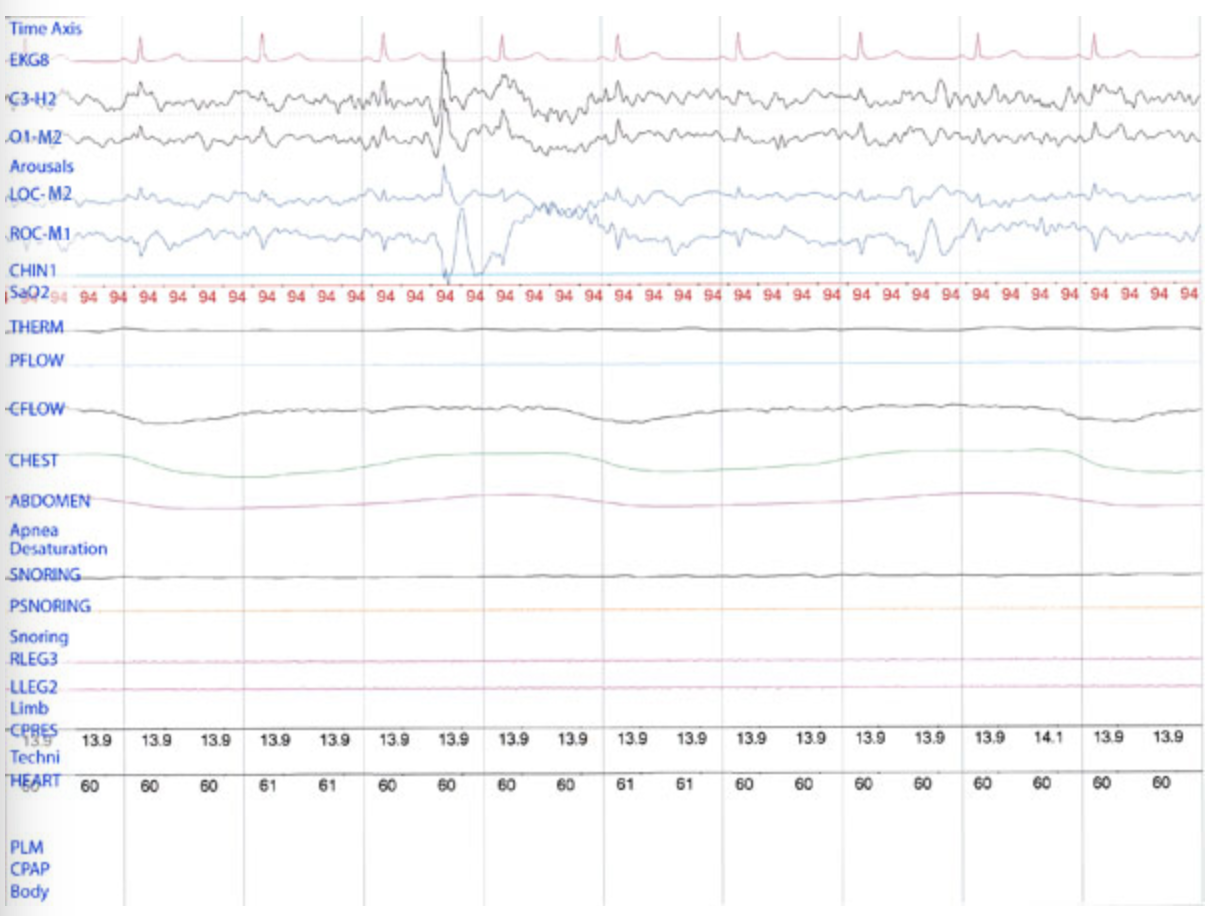
While scoring a sleep study of an adult, a sleep disorders specialist observes the following 10 second recording. The specialist should
Notify the interpreting physician of possible seizure activity